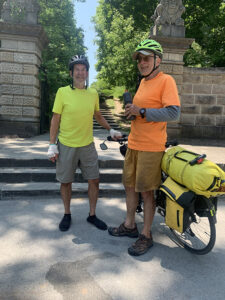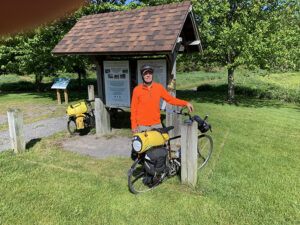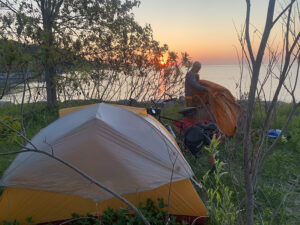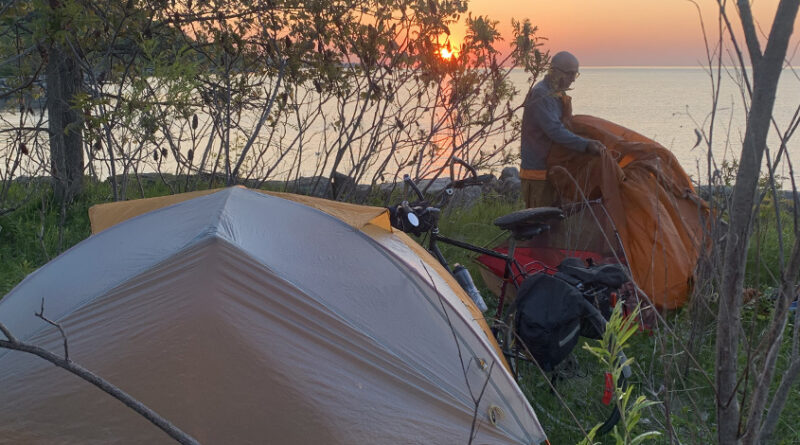A Ride Around Lake Ontario
It took two Rochester friends nine days and about 630 miles to circle Lake Ontario by bike
By Todd Etshman

What could be better than a ride along Lake Ontario with an old friend?
The answer for two avid cyclists and outdoor adventurers is nine days of riding 70 miles a day around the circumference of Lake Ontario, a journey of approximately 630 miles in total.
David Fergusson, 71, and Peter Mahler, 68, took that trip in late May–early June. They met at an outdoor adventure group, Pack, Paddle and Ski, a few years ago. The two previously biked the length of the Erie Canal but found the ride around the lake even more scenic.
“It’s hard to find someone to do a trip like this,” said Fergusson who previously rode across the country at the age of 60 and around other great lakes by himself. One thing he likes about Mahler is the ability to pack light and be ready to go first thing in the morning. Having someone else to face challenges is practical and uplifting, Fergusson explained.
“It’s easy to be with Dave. We can talk about a hundred different things. We’re very similar in a lot of ways,” Mahler said.
Finding someone who wants to bike that far, has the time and won’t back down from unexpected challenges isn’t easy, but Fergusson found that companion in Mahler, who has a long outdoor adventure history himself.
The journey took them on a multitude of trails in the U.S. and Canada, past bays, canals, locks, historical sites, parks and to an odd assortment of campsites. It took planning and cooperation between the two friends and the ability to adapt to impromptu situations that don’t show up on a map like bad weather, a meandering trail or a missing ferry in addition to finding food and bathroom facilities.
Making hotel or camp site reservations isn’t something they — and a host of other outdoor adventure enthusiasts — have to do. That’s because they embrace what is known as stealth or guerilla camping.
What that means is making a quick and efficient camp for the night anyplace that looks good — from a park to the dugout on a baseball field, an outdoor theater or behind a building amidst boat storage.

You just have to respect the property and don’t leave a mess, Mahler explained.
“When we leave, no one would know we were there,” he said.
There were no confrontations from angry landowners or park rangers on the journey, but as Mahler noted, it helps that “this is just two old guys on bikes.”
It’s a practice the pair said is easier in Canada than the U.S. And it’s not always necessary. Campers are allowed to set up at Erie Canal locks for example.
The trip started well enough on the familiar Erie Canal trail until cold, rainy, windy weather hit on Day 3 at historic Selkirk Shores State Park. But having more time to read historic markers is one of the appealing parts of the journey and War of 1812 history abounds here.
“We read every historical marker. That’s the fun of it,” Fergusson said.
Taking time to appreciate history and scenery is what makes the journey appealing. The pair enjoys the fact that they don’t have to rush by in a car anymore. They also got to stop for ice cream whenever they wanted.
Once inclement weather passed, the riders had the wind at their back for the next challenge, finding the ferry at Cape Vincent to Wolfe Island, Canada, closed.
Fortunately, a woman stopped to help them get on their way into Canada and onto the Great Lakes Waterfront Trail.
Quiet scenic trails and roads through farms and orchards with lake views made for happy biking through the Canadian countryside.

Another ferry between Kingston and Cobourg operated as planned and the Canadian side was full of scenic bays, peninsulas and lilacs bigger and bushier than any you can see in Highland Park, Mahler said.
Trails aren’t always easy to follow on a map or on the trail for cyclists looking to go an extra mile or in their case, an extra few hundred miles.
In one instance, the trail led to a beach in Cobourg. Pushing their bikes through the sand presented the pair with an additional upper body workout.
Heading toward Toronto the trail got better and more populated.
“Toronto was exciting with a two-lane bike and walking path that leads all through the city with its own traffic lights and signs,” Mahler said.
“There are some real resort towns west of Toronto that you’d never notice if you were driving on the 401,” Fergusson noted.
Seeing giant freighters is hard to do in Rochester (there is only one, the McKeil Spirit from Hamilton) but there is no shortage of them on the Welland Canal at St. Catherine’s. The sheer size of the ship they saw was fascinating to see making its way through the locks from Lake Ontario to Lake Erie.
From there, the men walked across the Rainbow Bridge and back to the Erie Canal Trail for the ride home — and as Mahler noted, a more comfortable bed and a return to all the trappings of everyday life and the distractions of our post-COVID-19 world.

